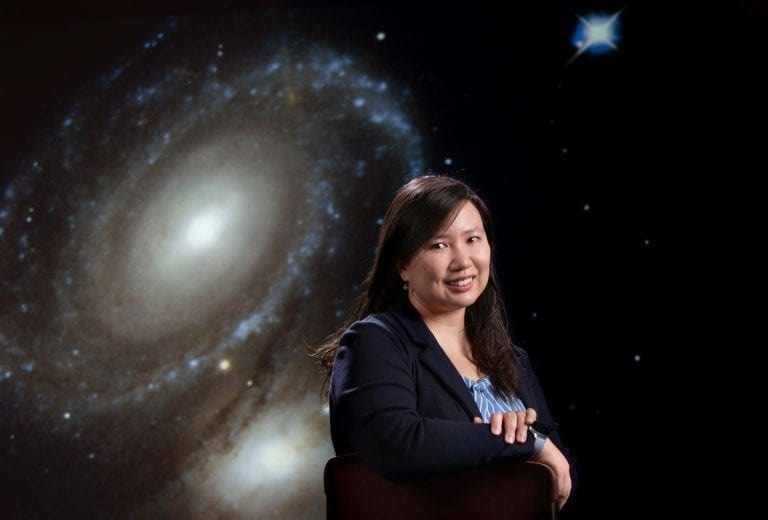Reviewed by Alex SmithNov 15 2022
An astronomers’ group at the University of California, Irvine, and other institutions is making use of unprecedentedly clear observations to disclose the secret inner workings of galaxies. This team was the first one to receive data transmissions from the James Webb Space Telescope.
 Vivian U, UCI assistant research scientist in physics and astronomy, is a member of a James Webb Space Telescope Early Release Science team that’s using access to data from the JWST’s advanced new instruments to learn unexpected things about nuclear dynamics in nearby galaxies. Steve Zylius / University of California Irvine.
Vivian U, UCI assistant research scientist in physics and astronomy, is a member of a James Webb Space Telescope Early Release Science team that’s using access to data from the JWST’s advanced new instruments to learn unexpected things about nuclear dynamics in nearby galaxies. Steve Zylius / University of California Irvine.
In a study reported recently in The Astrophysical Journal Letters, the scientists explain their analysis of the galaxy NGC 7469 in the vicinity of the JWST’s ultrasensitive mid-infrared detection instruments.
They performed the most elaborate analysis of the interactions between an active galactic nucleus dominated by a supermassive black hole and the star-developing galaxy regions encircling it.
What we are seeing in this system has been a surprise for us. Viewing this galaxy face-on, we are able to see not only winds from the supermassive black hole blowing in our direction but also ‘shock heating’ of the gas induced by said winds very close to the central active galactic nucleus, which is something we had not expected to be able to discern so clearly.
Vivian U, Study Lead Author and Assistant Research Scientist, Physics and Astronomy, University of California, Irvine
Vivian is also a member of one of 13 JWST Early Release Science teams.
U observed that shock heating occurs while a wind from a black hole in a galaxy’s center pushes the dense gas surrounding it. This is responsible for causing a shock front that deposits energy into the interstellar medium. This effect could impact the formation of stars in two opposing methods, stated Vivian.
By squeezing the gas into the molecular state, it exhibits the potential to promote the birth of new stars, or overly powerful feedback processes from the galactic wind can avoid birth by ruining stellar nurseries.
According to U, NGC 7469 is known as a Seyfert galaxy and an active center hosting a supermassive black hole and a ring of star-forming regions. For several years, astronomers have made an attempt to study the elaborate dynamics of these systems, which make up around 10% of all galaxies. However, dust, which is generally ample at the center of them, has made that a difficulty. The JWST provided U and her co-author entry to what lies behind the dust veil.
By making use of the telescope’s 6.5-meter mirror and sophisticated suite of tools, such as the Mid-Infrared Instrument, the scientists were capable to map various main ionized and molecular gas emission lines that notify astronomers regarding the conditions of the interstellar medium—the dust, gas, and radiation that are present between star systems in a galaxy. This identifies star-forming regions within a starburst ring.
Also, they detected a high-velocity outflow of ionized gas called “blueshifted,” implying it is coming toward the observer and traveling in the opposite direction.
The newly realized capability of mid-infrared integral field spectroscopy from the JWST’s Mid-Infrared Instrument now allows us to see not just what’s there behind the dust but also how things are moving at very small scales that we couldn’t previously see at these wavelengths.
Vivian U, Study Lead Author and Assistant Research Scientist, Physics and Astronomy, University of California, Irvine
U added, “We now have a more coherent picture—at least in this system—of how the active galactic nucleus is driving out gas and how that’s impacting the surrounding material. We see definitive signs of the black hole-driven winds dumping energy out into the interstellar medium.”
U stated that a considerable contributor to the roiling dynamics of NGC 7469 is the fact that it is combining with a second galaxy.
The interaction with another galaxy means that galactic materials are being moved around as a result of tidal forces, and they file toward the center of the galaxy system when angular momentum is lost. This process tends to make the galaxy center very dusty.
Vivian U, Study Lead Author and Assistant Research Scientist, Physics and Astronomy, University of California, Irvine
U added, “That’s why you need instruments like the ones aboard the JWST that allow us to peer through the dust and facilitate our understanding of the dusty cores of merging galaxies.”
The study’s principal investigators include U, Lee Armus at the Infrared Processing and Analysis Center at Caltech and Aaron Evans with the National Radio Astronomy Observatory in Virginia.
The study was financially supported by NASA and also on the basis of observations gathered from the James Webb Space Telescope. This was jointly functioned by NASA, the European Space Agency, and the Canadian Space Agency.
Journal Reference:
U, V., et al. (2022) GOALS-JWST: Resolving the Circumnuclear Gas Dynamics in NGC 7469 in the Mid-infrared. The Astrophysical Journal Letters. doi.org/10.3847/2041-8213/ac961c